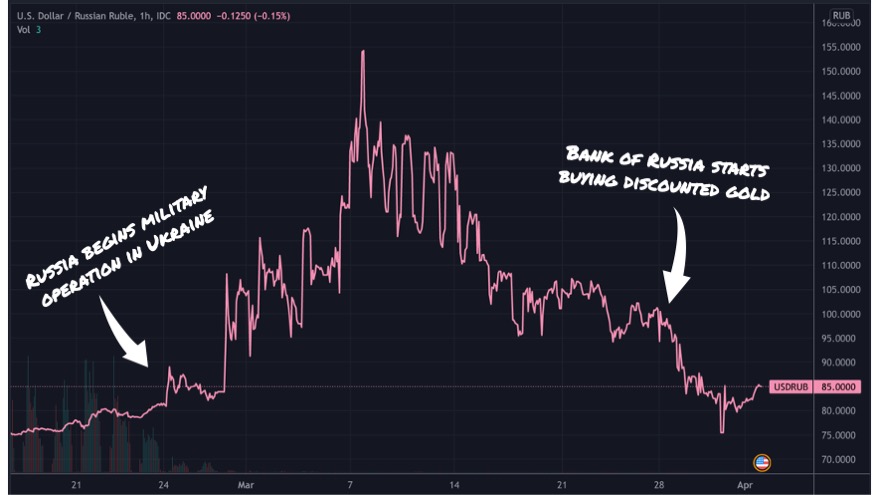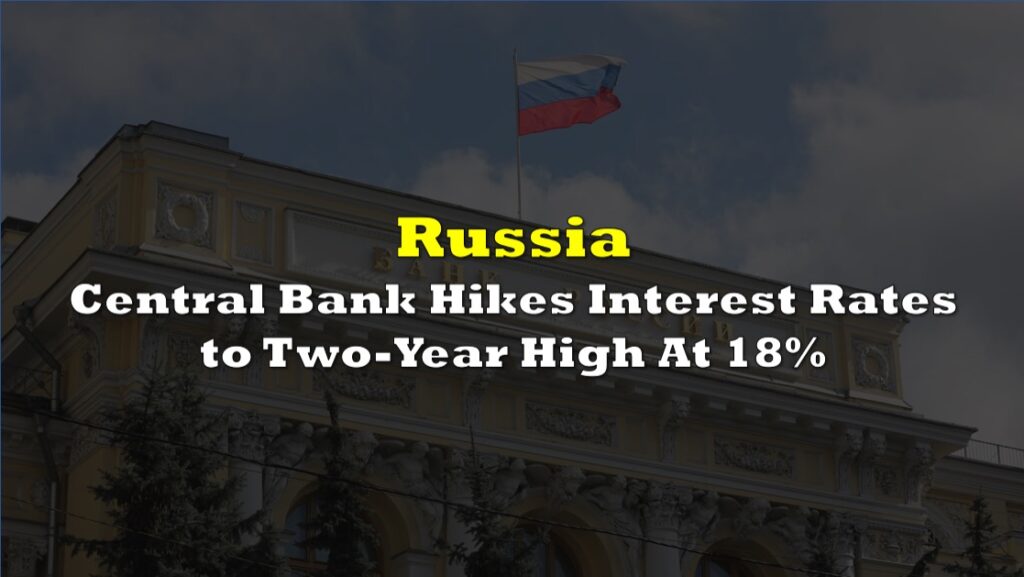Did Russia’s central bank just upend the entire global monetary system and unilaterally use the West’s sanctions to its advantage and link the ruble to the gold standard?
Certainly that would be unimaginable, because Washington’s sanctions were designed to choke off any life to Russia’s financial system to the point that it can no longer sustain the war in Ukraine, let alone its own economy. However, it appears that Moscow may have outsmarted the West again— or at least the Biden administration failed to think even one step ahead, because Russia’s central bank is now one step closer to transitioning into the gold standard, all thanks to Washington’s crude and gold trade restrictions.
The sanctions imposed against #Russia do not work, as evidenced by the strengthening of the ruble, said #Polish Prime Minister Mateusz Morawiecki pic.twitter.com/CWiUZlrJ9W
— NEXTA (@nexta_tv) April 2, 2022
Shortly after Russia’s invasion of Ukraine, the US and its allies decided to restrict Russia’s sale of gold reserves to foreign buyers, and slap secondary sanctions on any American entities making transactions in, or selling gold in the country. The move undoubtedly was aimed at preventing Russia from dipping into its last remaining lifeline to circumvent crippling sanctions, while its domestic currency is sent spiralling to historic lows.
But, here’s what’s actually happening, and why Washington has once again failed to recognize loopholes in its heaping sanction sandwich: shortly after the US blocked gold-related transactions with the Bank of Russia, the central bank announced it would start purchasing gold from domestic banks at 5,000 rubles per gram— and yes we are getting the IKEA commercial vibes, and no it’s not a mistake— it is a steal of a deal! But why would the banks be inclined to sell gold at such low rates unless their arm is twisted and they are forced to do so?
When the west sanctioned Moscow’s gold, it inadvertently created an arbitrage opportunity, whereby Russian gold becomes significantly cheaper than its foreign counterpart due to lack of outside market demand, particularly given the consequences of being caught buying the precious metal from Russia. Simply put, if the sanction sandwich is preventing you from selling your bullion reserves to foreign investors and all of a sudden the Bank of Russia comes along and offers to buy the gold at a slightly lower discount, you would happily sell because you are still making a premium.
And, its a win-win for Russia’s central bank, because it’s now boosting its gold reserves, subsequently upholding the ruble, and given that gold is traded in US dollars, setting a price floor for the ruble with respect to the US dollar. The next move for Russia is to boost foreign demand for its currency, which Putin did by instructing “unfriendly” nations to pay for Russian natural gas in rubles. Eventually, the initial discount of 5000 rubles per gram of gold will turn into a premium for the central bank, which in turn will strengthen the flow of gold into Russia from international markets, just as the domestic supplies start becoming depleted.

Still, Russia will ultimately have to liquidate some of its gold, otherwise how else would the country pay for the goods and services it needs? Well, not necessarily— all the central bank would have to do is proclaim the ruble as a substitute for gold at a determined exchange rate ie., the gold standard. However, before transitioning its entire economy, Russia must first ensure it has adequate gold reserves, which it is precisely doing right now by taking advantage of the arbitrage inadvertently created by Washington’s sanctions.
The real money question at the heart of this theme is how did the Biden administration and its allies not anticipate for such a scenario to play out? Simple: because the West’s myopic thought process is fixated on devaluing Russian gold with the hopes of limiting the amount of stuff the country can buy with it. In fact, Washington is so infatuated with preventing Russia from selling gold that it’s completely forgetting that gold is money, rather than the fiat paper created by a few strokes on the Fed’s keyboard that only has value in the first place because it can be traded for gold.
Russia de-valued the U.S. dollar by putting the ruble back on the gold standard. pic.twitter.com/8Xb8diao1R
— truth3rb0t 🎭 (@trutherbotnet) March 31, 2022
So, what does this mean for the ruble, gold, the US dollar? For starters, with Russia linking the ruble to gold and then linking payments for commodity exports to the ruble, the central bank is essentially shifting the entire paradigm of global trade, whilst fundamentally altering the global monetary arrangement as we know it. If countries begin accepting Putin’s terms of using rubles for commodity payments, Russia’s ruble could shore up substantial demand and quickly become a major global currency.
The Bank of Russia’s move to link ruble to gold and link commodity payments to ruble is a paradigm shift that the Western media has not yet grasped. As the dominos fall, these events may change everything. Increased demand for gold, a revalued gold price, a shift away from USD.
— Kim Dotcom (@KimDotcom) April 2, 2022
Simultaneously, the move would also boost the global demand for gold, while shift demand away from the US dollar amid increased commodity trade in other currencies. Could this be… the coming of a new world order?
Information for this briefing was found via Reuters, RT News, and the sources mentioned. The author has no securities or affiliations related to this organization. Not a recommendation to buy or sell. Always do additional research and consult a professional before purchasing a security. The author holds no licenses.










3 Responses
So if it was such a nice little evil-genius earner, why have they stopped doing it?
USD as the global reserve currency, is a ‘dying swan’, that has become obvious to many. However, it is believed that, due to its growing economy, China’s Yuan was the favourite to ascend to that status. If Russia maintains it’s strategy, the Ruble (PEG’d against gold) could become the new reserve currency, a far more stable currency unlike the Wests fiat counterpart’s.
A + to you sir. Yea they just enriched Russia considerebly. What we in the east call ” American Moronizm.